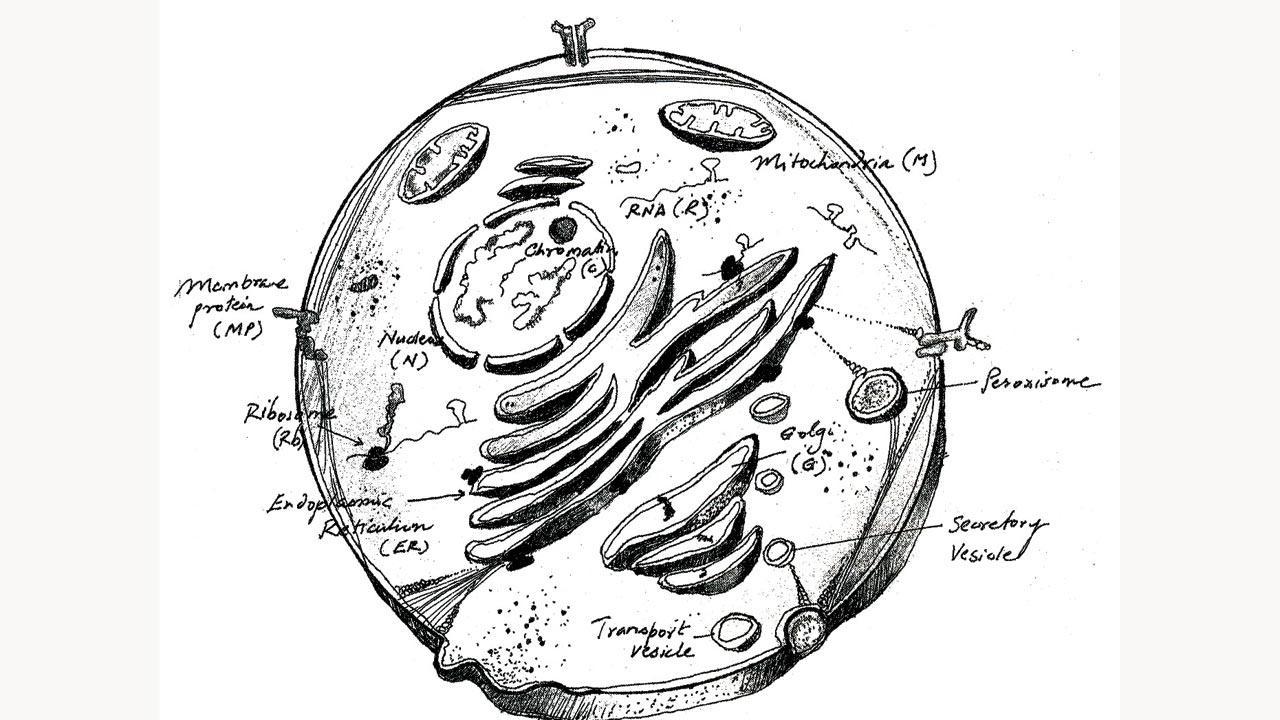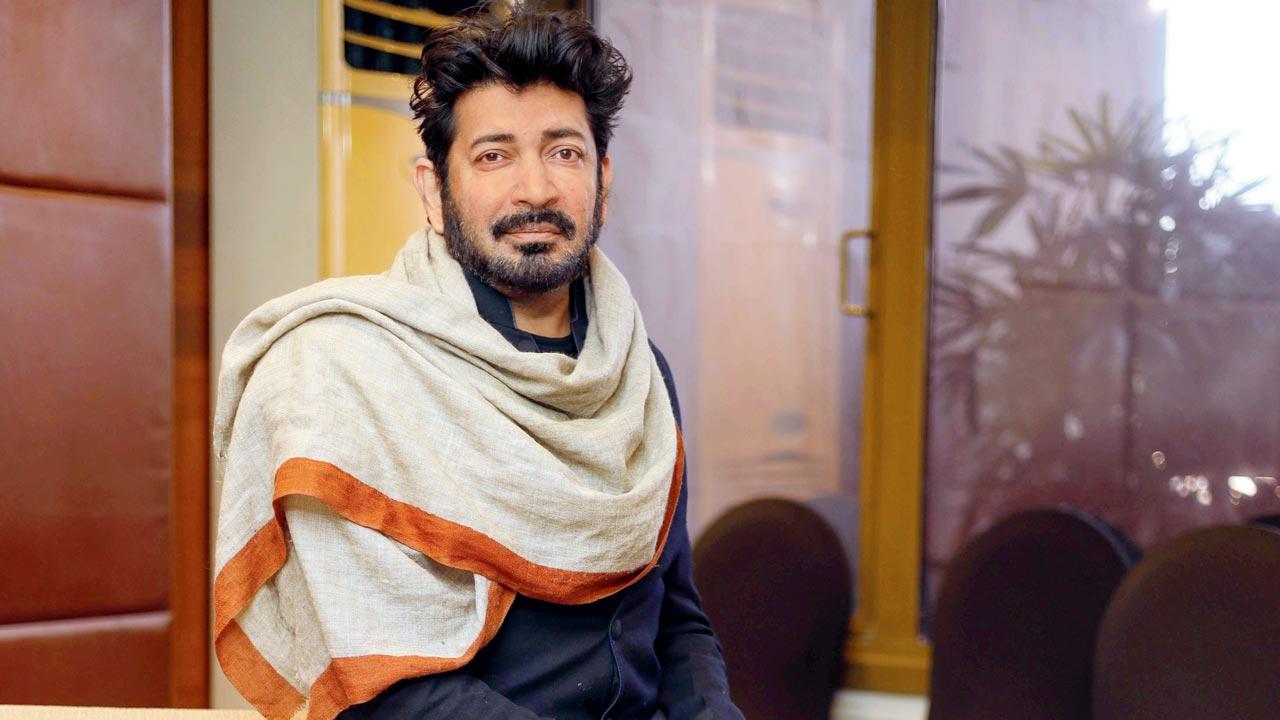In his latest title, cancer physician, researcher and bestselling author Dr Siddhartha Mukherjee chooses to focus on the tiniest structural and functional units of living beings

Author’s rendition of a cell, showing its various substructures, including the ER (endoplasmic reticulum), N (nucleus), R (RNA), CM (cell membrane), C (chromatin), P (peroxisome), G (golgi), M (mitochondria), Rb (ribosome), MP (membrane protein). The strands within the cell correspond to elements of the cytoskeleton. Note that the drawing is not to scale. Illustration taken from The Song of the Cell: An Exploration of Medicine and the New Human
Before an audience of New Yorkers at the National Sawdust concert-hall in a pre-pandemic world, a bearded vocalist in a black cotton kurta and complimenting pants, starts singing a composition in Raag Kirwani. “I am a vocalist and I can play the tabla to save my life,” he says, smiling, as we zoom out of this YouTube video in New Delhi, his birth-city, on a freezing January morning in 2023.
Dr Siddhartha Mukherjee, 52, saves lives, indeed, as a cancer physician, researcher and Assistant Professor of Medicine at Columbia University. But also, as a
Pulitzer-winning author, Dr Mukherjee is the writer of four books that explain the workings of the human body—cells and genes, and cancer, the indefatigable affliction of this body.
He continues to deepen life’s understanding in his latest title, The Song of the Cell: An Exploration of Medicine and the New Human, whose protagonists are cells, the units of life (and “what is “life”?”).
 Disarming vulnerability is another power of this book. Dr Mukherjee lets himself be the centre in such instances: sharing his own struggle with depression; detailing the emotional effects of his family’s move during the 1947 Partition of South Asia; or his own rootlessness in moving abroad to train in medicine. Pic/Nishad Alam
Disarming vulnerability is another power of this book. Dr Mukherjee lets himself be the centre in such instances: sharing his own struggle with depression; detailing the emotional effects of his family’s move during the 1947 Partition of South Asia; or his own rootlessness in moving abroad to train in medicine. Pic/Nishad Alam
As he transfers the melody to Jog Blues’ sitarist, who then rouses the harmonica, a musical relay carries it to the clarinet, the tabla, drums, cello, and guitars; then they all come together. “Kya baat hai!” he exclaims to his band-mates.
With similar marvel and with metaphors, his book explains the working of cells in a manner inviting even the one who hasn’t read biology after middle school. “A gene without a cell is lifeless… [like] a musical score without a musician,” he writes.
This book is parked at a momentous cross-section of medical history, microbiology, memoir, philosophy, and contemporary commentary. Deep research, gripping story-telling, honest reflections, empathy, and vulnerability, punctuate it.
In his 2015 TED talk, Dr Mukherjee lays down the model for curing diseases with cells than with pills. This thought is the pulse of The Song, while it tells the functions, wonders, and possibilities of cells. It places in cell alteration, the causal and remedial possibility of everything—from cancer and heart disease, to depression.
But the Coronavirus pandemic took everyone by surprise, including Dr Mukherjee, who wrote much of this title in this duration.
“At its core, the pandemic too was a disease of cells,” he writes. In case of SARS-CoV2, immunological coordination turns into “immunological misfiring,” i.e., a dysregulation of immune cells, he explains this term by Yale University virologist Akiko Iwasaki.
Profound and compassionate reflections carry this book’s narrative, and also Dr Mukherjee’s conversations.
He recalls watching nurses line up for duty during pre-vaccine pandemic and puts a thought to their “under-appreciated service”.
During this time, even his cancer clinic at the hospital was trimmed, and he was isolating at his New York home with his wife and two daughters.
He admittedly makes “not-so-subtle” commentary on India’s devastating second-wave response. The Song notes the ceaseless death-toll, reflecting in burning bodies at every visible public space.
“What’s the point of any writing or journalism if you’re going to censor yourself?” he says.
It is impossible to be unaffected by The Song’s joyousness in detailing cell-biology discoveries–from the first microscope by a Dutch cloth-seller watching “animalcules” in rain and sea water, to the first “test-tube baby,” Louise Joy Brown, whose arrival preceded such mad excitement, that doctors had to hoodwink journalists crowding the hospital.
He suffixes such medical-history anecdotes with his personal milestones. Sample this: Every time I see a cell under a microscope, refulgent, glimmering, alive, I relive the thrill of seeing my first cell [in 1993].
Dr Mukherjee’s writing style, informed by his own appetite for curiosity, makes the reader feel they are actual witnesses to these historical moments. In these nuggets, it’s hard to tell we’re reading a non-fiction book on microbiology.
But along with measured hat-tipping to scientists and their innovations, he also acknowledges the ethical failings of his fraternity.
Citing patient and personal-family details also involve extensive legwork in consent-taking that Dr Mukherjee navigates as a matter of course, and with
anonymising sources where the situation demands.
Watching the world with a deep sense of empathy and reflection hits intensely in certain passages. For instance, in the extract about his meeting with Emily Whitehead, the first paediatric patient whose cancer was treated with a kind of cellular engineering, of infusing her body with her own T cells to kill the cancer.
“I wondered how she felt, knowing that there were three versions of her in the hospital: the one here today, on a break from school; the one in the pictures who had lived and almost died in ICU; and the one frozen in the Krusty the Clown freezer [as her cells] next door.”
It’s not unsurprising that he says, “Most importantly, I write for my patients,” even though his books have a massive readership among people of all walks, and especially in those from the scientific community.
Disarming vulnerability is another power of this book. Dr Mukherjee lets himself be the centre in such instances: sharing his own struggle with depression; detailing the emotional effects of his family’s move during the 1947 Partition of South Asia; or his own rootlessness in moving abroad to train in medicine.
“I make myself vulnerable so that the reader doesn’t feel attacked or exposed,” he says, about the passage contextualising his most profound wave of depression.
He explains depression, too, as an “alteration with cell signalling and neurons” while also acknowledging that “there are situational and environmental factors that ultimately impinge on the cells” in case of depression, anxiety, and other such conditions.
With at least 280 million worldwide living with depression, in addition to other mood disorders, this is promising insight. “So, there’s a sense of relief that if the reason [for depression] is biological, there is also the possibility of a biological intervention,” he says.
It’s the sum of such interventions that The Song calls the exploration of the “new human”: a human rebuilt anew with modified cells. These humans are altered to alleviate suffering, using handcrafted and personalised science.
Oh, and there’s understated humour. For instance, in the passage about the earliest IVF experiments, summarising that human eggs took longer to ripen for fertilisation compared to those of rabbits, Dr Mukherjee writes: “The moral? We don’t reproduce like rabbits. Our eggs need a little more seduction.”
Since his first book The Emperor of All Maladies: A Biography of Cancer, Dr Mukherjee says each book is its own adventure but The Song was most difficult to structure. It’s because discoveries in cell biology have been simultaneous, untethered by any neat chronology.
So, the book is pieced to read as a series of inter-connected short stories, each chapter a story. He has also done illustrations that the book carries; he admits as a humble-brag.
We also know the writer to be an ardent reader of literature: A William Shakespeare quote here, a Kazuo Ishiguro novel reference there, and a Carl Sandburg poem (The fog comes/ on little cat feet; to describe his depressive fog), among many others.
There is an inter-textuality, a sense of this literature belonging with all that has ever been and will ever be written.
He credits his editors for nudging the better out of his writing: “they said the chapter on heart doesn’t have enough heart,” he says about the most evocative of chapters in The Song, The Citizen Cell: The Benefits of Belonging. He rewrote that one to introduce it in its current form: with lyrical personal details and philosophical mulling about love, rootlessness, and the desire to belong in people and places.
The celebratory sense with which he writes of his first home-coming to New Delhi as a student of Standford University is tear-inducing. And with this, the reader is taken to a sympathetic understanding of the heart’s mechanics: the heart is a model of cellular cooperation, citizenship, and belonging.
Dr Mukherjee’s belonging with his homeland seems to stay as thick. Later in the day after our conversation, he is headed for Bengaluru, where he is currently invested in collaborative clinical trials for newer cancer therapies.
This cancer physician’s music converges with his writing: a raag fusing into Jazz classic ‘Summertime’. An Asian, night-time raag and a Western classic fit perfectly to create a new piece. “It is a new sum of new parts.”
 Subscribe today by clicking the link and stay updated with the latest news!" Click here!
Subscribe today by clicking the link and stay updated with the latest news!" Click here!










